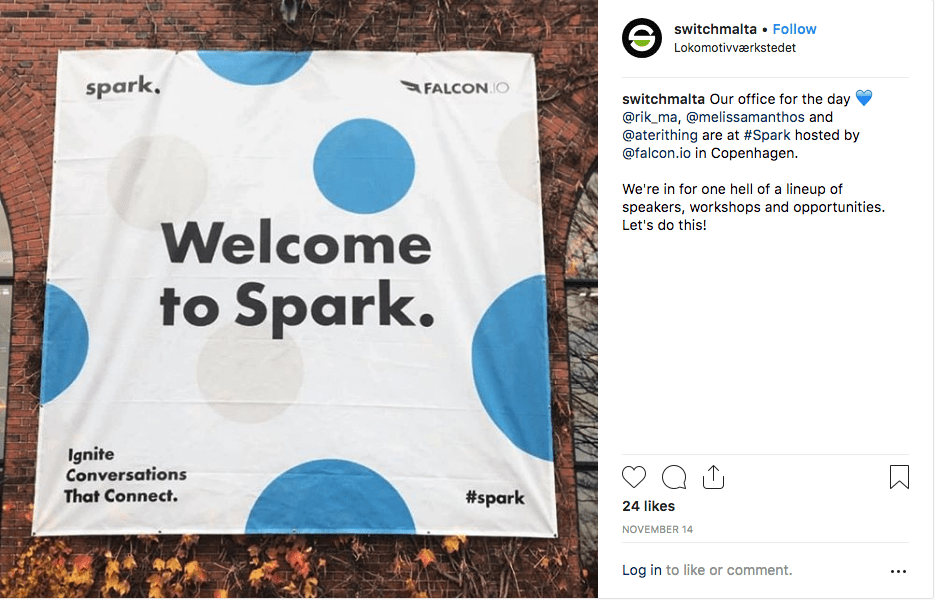In November I travelled to Copenhagen with a couple of colleagues to attend the first edition of Spark – a social media marketing conference organised by Falcon.IO, a social media marketing tool we use for a few of our clients.
It was an incredible experience, but I’m not here to reminisce. Seeing that there were the hottest minds in European Social Media Marketing, I will share the key insights we returned back to base with. There’s far too much to put down in one blog post, so I’m going to focus on our learnings that linked how you can make financial sense of social media marketing.

Let’s start with one assumption – social media marketing is not a choice. I can confidently say that the majority of businesses need a planned social media presence, no matter what industry they’re in.
The medium (or media) you’re on, the strategy you employ, and the content you post will vary based on the business you’re in, however, if you’re not using social media as part of your media mix, then you’re missing out on opportunities. And your competitors definitely aren’t all making the same mistake, so some of them inherently have a competitive advantage.
In itself that statement isn’t enough to convert non-believers. It’s not even enough to help believers convert their non-believing bosses, which is why I’m here to help the case with a series of arguments in favour of the financial sense it makes to get your business onto social media, fast.
Customer experience
The first, and probably most important part of the equation, and in my mind an irrefutable argument for a social media presence, is that your customers are on social media. So if you ignore social media (or if you have a haphazard approach to it), you’re ignoring a crucial touchpoint in the customer experience journey.

As Ulrik Bo Larsen, CEO of Falcon.IO, said in Copenhagen, we’re perfectly optimising marketing for a world that no longer exists. We have to evolve or else we’re going to expire. This is a mistake that so many people make over the years – think of Nokia, who came out with the first smartphones for a world that had moved past their vision of it. People did not want their phones for spreadsheets. They might have needed them for spreadsheets, but they wanted them to play music on, to take photos on, to connect to social media, to send photos of their kids to their mums.

If you ignore social media as an integral part of your customers’ experience, or even worse if you’re ignoring your customer experience, then you are at risk of becoming irrelevant. It’s not a financial argument to make to your boss. It’s a terrifying reality you need to highlight them to.
Excellent ROI
This isn’t something we learned at Spark, but it’s definitely worth mentioning, because no matter how old or how young, there is one language all entrepreneurs get: Return On Investment. Social media, when done well, has proven to offer excellent return on investment when compared to all other conventional channels.
We’re not telling you to replace all other channels with social alone, social works best when supported by and when supporting other channels. I’m not going to delve too deep into this one. There’s tonnes of research out there that you can find with a simple Google search.
I’ll just contribute one statistic:
For under the price of a couple of billboards a month one of our clients regularly reaches the equivalent of the entire population of Malta 4-fold.
Consumers love brands that don’t act like one
This is as much of a recommendation as it is an eye-opener. One of the biggest pushbacks we receive from social media nay-sayers is that people don’t follow brands on social media – they follow their friends and family.
Hanne Grainger, Global Social & Content Brand Manager at Irish Distillers (Jameson Whiskey), says that the top 10 most followed brands on Instagram have 450 million followers. That’s as much as 19 Western European countries put together (including the UK, France, Germany, Poland and Italy).
People DO follow brands. They just don’t want to follow brands that act like brands. We’ve been saying this since 2014 at Switch, too – Digital is Human. People want to follow brands that have personality. Brands that feel human.

Audience & Product insight
In Copenhagen, Sabrina Rodriguez, Global Head of Social & Content at Dentsu Aegis Network, also explained how using social media well gives you amazing insights into your audiences, your competition and your product.
By using the right tools to listen to what people are saying about you and your competitors you can react quickly to potential hiccups and be proactive in getting on the next trends and viral content before anyone else can.
Reddit, Facebook and LinkedIn groups can also be excellent ways to poll your current users for insight into your product service or offering. Instead of going out to a random sample of users, you can get people who actually are invested in your brand to have conversations about you in a place that feels safe. This will be far more insightful than what you can get from people who don’t know your brand or have never interacted with it directly.
And in the end…
So if you are having trouble justifying the investment in social media marketing it is probably because you haven’t looked into the financial rewards that you can reap.
Let’s have a chat and see how we can help you make sense of it all.




